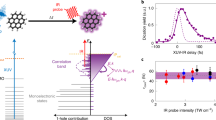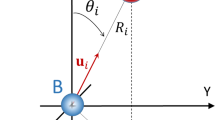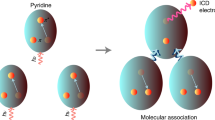Abstract
Irradiation of matter with light tends to electronically excite atoms and molecules, with subsequent relaxation processes determining where the photon energy is ultimately deposited and electrons and ions produced. In weakly bound systems, intermolecular Coulombic decay1 (ICD) enables very efficient relaxation of electronic excitation through transfer of the excess energy to neighbouring atoms or molecules that then lose an electron and become ionized2,3,4,5,6,7,8,9. Here we propose that the emission site and energy of the electrons released during this process can be controlled by coupling the ICD to a resonant core excitation. We illustrate this concept with ab initio many-body calculations on the argon–krypton model system, where resonant photoabsorption produces an initial or ‘parent’ excitation of the argon atom, which then triggers a resonant-Auger-ICD cascade that ends with the emission of a slow electron from the krypton atom. Our calculations show that the energy of the emitted electrons depends sensitively on the initial excited state of the argon atom. The incident energy can thus be adjusted both to produce the initial excitation in a chosen atom and to realize an excitation that will result in the emission of ICD electrons with desired energies. These properties of the decay cascade might have consequences for fundamental and applied radiation biology and could be of interest in the development of new spectroscopic techniques.
This is a preview of subscription content, access via your institution
Access options
Subscribe to this journal
Receive 51 print issues and online access
$199.00 per year
only $3.90 per issue
Buy this article
- Purchase on Springer Link
- Instant access to full article PDF
Prices may be subject to local taxes which are calculated during checkout


Similar content being viewed by others
References
Cederbaum, L. S., Zobeley, J. & Tarantelli, F. Giant intermolecular decay and fragmentation of clusters. Phys. Rev. Lett. 79, 4778–4781 (1997)
Jahnke, T. et al. Ultrafast energy transfer between water molecules. Nature Phys. 6, 139–142 (2010)
Mucke, M. et al. A hitherto unrecognized source of low-energy electrons in water. Nature Phys. 6, 143–146 (2010)
Grieves, G. A. & Orlando, T. M. Intermolecular Coulomb decay at weakly coupled heterogeneous interfaces. Phys. Rev. Lett. 107, 016104 (2011)
Schwartz, C. P., Fatehi, S., Saykally, R. J. & Prendergast, D. Importance of electronic relaxation for inter-Coulombic decay in aqueous systems. Phys. Rev. Lett. 105, 198102 (2010)
Stoychev, S. D., Kuleff, A. I. & Cederbaum, L. S. Intermolecular Coulombic decay in small biochemically relevant hydrogen-bonded systems. J. Am. Chem. Soc. 133, 6817–6824 (2011)
Hergenhahn, U. Interatomic and intermolecular Coulombic decay: the early years. J. Electron Spectrosc. Relat. Phenom. 184, 78–90 (2011)
Sisourat, N. et al. Ultralong-range energy transfer by interatomic Coulombic decay in an extreme quantum system. Nature Phys. 6, 508–511 (2010)
Havermeier, T. et al. Interatomic Coulombic decay following photoionization of the helium dimer: observation of vibrational structure. Phys. Rev. Lett. 104, 133401 (2010)
Kim, H. K. et al. Enhanced production of low energy electrons by alpha particle impact. Proc. Natl Acad. Sci. USA 108, 11821–11824 (2011)
Santra, R. & Cederbaum, L. S. Coulombic energy transfer and triple ionization in clusters. Phys. Rev. Lett. 90, 153401 (2003)
Morishita, Y. et al. Experimental evidence of interatomic Coulombic decay from the Auger final states in argon dimers. Phys. Rev. Lett. 96, 243402 (2006)
Yamazaki, M. et al. Decay channel dependence of the photoelectron angular distributions in core-level ionization of Ne dimers. Phys. Rev. Lett. 101, 043004 (2008)
Ueda, K. Core excitation and de-excitation spectroscopies of free atoms and molecules. J. Phys. Soc. Jpn 75, 032001 (2006)
Feyer, V. et al. Core level study of alanine and threonine. J. Phys. Chem. A 112, 7806–7815 (2008)
Hergenhahn, U. et al. The resonant Auger spectra of formic acid, acetaldehyde, acetic acid and methyl formate. Chem. Phys. 289, 57–67 (2003)
de Gouw, J. A., van Eck, J., Peters, A. C., van der Weg, J. & Heideman, H. G. M. Resonant Auger spectra of the 2p−1nl states of argon. J. Phys. B 28, 2127–2141 (1995)
Fuggle, J. C. & Alvarado, S. F. Core-level lifetimes as determined by X-ray photoelectron spectroscopy measurements. Phys. Rev. A 22, 1615–1624 (1980)
Gorczyca, T. W. & Robicheaux, F. Auger decay of the photoexcited 2p−1nl Rydberg series in argon. Phys. Rev. A 60, 1216–1225 (1999)
Trinter, F. et al. Resonant Auger decay driving intermolecular Coulombic decay in molecular dimers. Nature http://dx.doi.org/10.1038/nature12927 (this issue)
Kay, A. et al. Multi-atom resonant photoemission: a method for determining near-neighbor atomic identities and bonding. Science 281, 679–683 (1998)
Carravetta, V. & Ågren, H. An ab initio method for computing multi-atom resonant photoemission. Chem. Phys. Lett. 354, 100–108 (2002)
Pomplun, E. A new DNA target model for track structure calculations and its first application to I-125 Auger electrons. Int. J. Radiat. Biol. 59, 625–642 (1991)
von Sonntag, C. Free-Radical-Induced DNA Damage and Its Repair (Springer, 2006)
Adelstein, J. S., Kassis, A. I., Bodei, L. & Mariani, G. Radiotoxicity of iodine-125 and other Auger-electron-emitting radionuclides: background to therapy. Cancer Biother. Radiopharm. 18, 301–316 (2003)
Fairchild, R. G., Brill, A. B. & Ettinger, K. V. Radiation enhancement with iodinated deoxyuridine. Invest. Radiol. 17, 407–416 (1982)
Aziz, E. F., Ottosson, N., Faubel, M., Hertel, I. V. & Winter, B. Interaction between liquid water and hydroxide revealed by core-hole de-excitation. Nature 455, 89–91 (2008)
Pokapanich, W. et al. Ionic-charge dependence of the intermolecular Coulombic decay time-scale for aqueous ions probed by the core-hole clock. J. Am. Chem. Soc. 133, 13430–13436 (2011)
Boudaïffa, B., Cloutier, P., Hunting, D., Huels, M. A. & Sanche, L. Resonant formation of DNA strand breaks by low-energy (3 to 20 eV) electrons. Science 287, 1658–1660 (2000)
Martin, F. et al. DNA strand breaks induced by 0–4 eV electrons: the role of shape resonances. Phys. Rev. Lett. 93, 068101 (2004)
Hausamann, D. & Morgner, H. The heteronuclear rare gas ions. A simple model for the determination of the potential curves. Mol. Phys. 54, 1085–1099 (1985)
Stoychev, S. D., Kuleff, A. I., Tarantelli, F. & Cederbaum, L. S. On the interatomic electronic processes following Auger decay in neon dimer. J. Chem. Phys. 129, 074307 (2008)
Demekhin, Ph. V. et al. Interatomic Coulombic decay in NeAr following K-LL Auger transition in the Ne atom. J. Chem. Phys. 131, 104303 (2009)
National Institute of Standards and Technology. NIST Atomic Spectra Databasehttp://physics.nist.gov/asd (2012)
Averbukh, V. & Cederbaum, L. S. Ab initio calculation of interatomic decay rates by a combination of the Fano ansatz, Green’s-function methods, and the Stieltjes imaging technique. J. Chem. Phys. 123, 204107 (2005)
Fano, U. Effects of configuration interaction on intensities and phase shifts. Phys. Rev. 124, 1866–1878 (1961)
Schirmer, J., Trofimov, A. B. & Stelter, G. A non-Dyson third-order approximation scheme for the electron propagator. J. Chem. Phys. 109, 4734–4744 (1998)
Hasi, A. U. in Electron-Molecule and Photon-Molecule Collisions (eds Rescigno, T., McKoy, V. & Schneider, B. ) 281–298 (Plenum, 1979)
Peterson, K. A., Figgen, D., Goll, E., Stoll, H. & Dolg, M. Systematically convergent basis sets with relativistic pseudopotentials. II. Small-core pseudopotentials and correlation consistent basis sets for the post-d group 16-18 elements. J. Chem. Phys. 119, 11113–11123 (2003)
Woon, D. E. & Dunning, T. H. Gaussian basis sets for use in correlated molecular calculations. III. The atoms aluminum through argon. J. Chem. Phys. 98, 1358–1371 (1993)
Wilson, A. K., Woon, D. E., Peterson, K. A. & Dunning, T. H. Gaussian basis sets for use in correlated molecular calculations. IX. The atoms gallium through krypton. J. Chem. Phys. 110, 7667–7676 (1999)
Santra, R., Zobeley, J. & Cederbaum, L. S. Electronic decay of valence holes in clusters and condensed matter. Phys. Rev. B 64, 245104 (2001)
Öhrwall, G. et al. Femtosecond interatomic Coulombic decay in free neon clusters: large lifetime differences between surface and bulk. Phys. Rev. Lett. 93, 173401 (2004)
Müller, I. B. & Cederbaum, L. S. Ionization and double ionization of small water clusters. J. Chem. Phys. 125, 204305 (2006)
Stoychev, S. D., Kuleff, A. I. & Cederbaum, L. S. On the intermolecular Coulombic decay of singly and doubly ionized states of water dimer. J. Chem. Phys. 133, 154307 (2010)
Ottosson, N., Öhrwall, G. & Björneholm, O. Ultrafast charge delocalization dynamics in aqueous electrolytes: new insights from Auger electron spectroscopy. Chem. Phys. Lett. 543, 1–11 (2012)
Öhrwall, G. et al. Charge dependence of solvent-mediated intermolecular Coster-Kronig decay dynamics of aqueous ions. J. Phys. Chem. B 114, 17057–17061 (2010)
Huels, M. A., Boudaïffa, B., Cloutier, P., Hunting, D. & Sanche, L. Single, double, and multiple double strand breaks induced in DNA by 3-100 eV electrons. J. Am. Chem. Soc. 125, 4467–4477 (2003)
Milne-Brownlie, D. S. et al. Dynamics in electron-impact ionization of H2O. Phys. Rev. A 69, 032701 (2004)
McCarthy, I. E. & Weigold, E. Electron momentum spectroscopy of atoms and molecules. Rep. Prog. Phys. 54, 789–879 (1991)
Surdutovich, E. & Solov’yov, A. V. Multiscale physics of ion-beam cancer therapy. J. Phys. Conf. Ser. 373, 012001 (2012)
Acknowledgements
The research leading to these results received funding from the European Research Council under the European Community’s Seventh Framework Programme (FP7/2007-2013)/ERC Advanced Investigator Grant no. 227597. P.K. acknowledges the support from the Czech Science Foundation (grant no. P208/12/0521).
Author information
Authors and Affiliations
Contributions
K.G., A.I.K. and L.S.C. had the idea for the cascade mechanism and its potential consequences. P.K. computed the lifetimes, and K.G. and A.I.K. evaluated the electronic spectra. K.G., A.I.K. and L.S.C. wrote the paper.
Corresponding authors
Ethics declarations
Competing interests
The authors declare no competing financial interests.
Extended data figures and tables
Extended Data Figure 1 Model potential energy curves of the initial and final ICD states of ArKr produced on excitation at 246.51 eV.
The horizontal lines indicate the potential energy curves of the excited valence-ionized states produced through the resonant Auger decay of the parent state following Ar( ) core excitation at 246.51 eV. The steep curves indicate the potential energy of the two-site doubly ionized final states obtained after ICD. The relative populations of the final resonant Auger states are given in per cent. Only states acquiring more than 5% of the total population are depicted. The equilibrium distance of the neutral ArKr (Req = 3.88 Å) is shown as a vertical dotted line.
) core excitation at 246.51 eV. The steep curves indicate the potential energy of the two-site doubly ionized final states obtained after ICD. The relative populations of the final resonant Auger states are given in per cent. Only states acquiring more than 5% of the total population are depicted. The equilibrium distance of the neutral ArKr (Req = 3.88 Å) is shown as a vertical dotted line.
Extended Data Figure 2 Model potential energy curves of the initial and final ICD states of ArKr produced on excitation at 246.93 eV.
The horizontal lines indicate the potential energy curves of the excited valence-ionized states produced through the resonant Auger decay of the parent state following Ar( ) core excitation at 246.93 eV. The steep curves indicate the potential energy of the two-site doubly ionized final states obtained after ICD. The relative populations of the final resonant Auger states are given in per cent. Only states acquiring more than 5% of the total population are depicted. The equilibrium distance of the neutral ArKr (Req = 3.88 Å) is shown as a vertical dotted line.
) core excitation at 246.93 eV. The steep curves indicate the potential energy of the two-site doubly ionized final states obtained after ICD. The relative populations of the final resonant Auger states are given in per cent. Only states acquiring more than 5% of the total population are depicted. The equilibrium distance of the neutral ArKr (Req = 3.88 Å) is shown as a vertical dotted line.
PowerPoint slides
Rights and permissions
About this article
Cite this article
Gokhberg, K., Kolorenč, P., Kuleff, A. et al. Site- and energy-selective slow-electron production through intermolecular Coulombic decay. Nature 505, 661–663 (2014). https://doi.org/10.1038/nature12936
Received:
Accepted:
Published:
Issue Date:
DOI: https://doi.org/10.1038/nature12936
This article is cited by
-
Radiation damage by extensive local water ionization from two-step electron-transfer-mediated decay of solvated ions
Nature Chemistry (2023)
-
Triple ionization and fragmentation of benzene trimers following ultrafast intermolecular Coulombic decay
Nature Communications (2022)
-
Ambient-light-induced intermolecular Coulombic decay in unbound pyridine monomers
Nature Chemistry (2022)
-
Impact of cavity on interatomic Coulombic decay
Nature Communications (2021)
-
Ultrafast relaxation of photoexcited superfluid He nanodroplets
Nature Communications (2020)
Comments
By submitting a comment you agree to abide by our Terms and Community Guidelines. If you find something abusive or that does not comply with our terms or guidelines please flag it as inappropriate.



